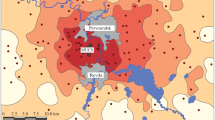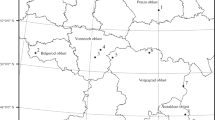Abstract
The state of tree and ground vegetation layers in spruce-fir forests around the Middle Ural Copper Smelter (Revda, Sverdlovsk oblast) has been repeatedly evaluated in 25 permanent sampling plots at 5- to 10-year intervals (1989–2013). The results have been used to characterize the dynamics of plant communities in the period of reduction of emissions from the smelter. Although the annual amount of emissions has decreased from 150–225 × 103 t in the 1980s to less than 5 × 103 t after 2010, the vegetation in the impact zone (1 and 2 km from the smelter) remains severely suppressed: the trees continue to die off, and the diversity of ground vegetation layer is very low. In zones with low and moderate levels of industrial pollution (30 and 4–7 km from the smelter), natural factors associated with windfall disturbance after the 1995 windstorm with snow have played a more important role in the dynamics of forest communities than the reduction of emissions itself.
Similar content being viewed by others
References
Bates, J.W., Bell, J.N.B., and Massara, A.C., Loss of Lecanora conizaeoides and other fluctuations of epiphytes on oak in S.E. England over 21 years with declining SO2 concentrations, Atmos. Environ., 2001, vol. 35, no. 14, pp. 2557–2568.
Belyaeva, N.V., Disastrous windfall and transformations of herb-dwarf shrub and moss layers in forests of the Visim Reserve, in Posledstviya katastroficheskogo vetrovala dlya lesnykh ekosistem (Consequences of Disastrous Windfall for Forest Ecosystems), Yekaterinburg, 2000, pp. 46–62.
Chernen’kova, T.V. and Bochkarev, Yu.N., Dynamics of spruce stands in the Kola Peninsula under the effect of natural and anthropogenic environmental factors, Zh. Obshch. Biol., 2013, vol. 74, no. 4, pp. 283–303.
Chernen’kova, T.V., Kabirov, R.R., Mekhanikova, E.V., et al., Demutation of vegetation after copper smelter shut-down, Lesovedenie, 2001, no. 6, pp. 31–37.
Chernen’kova, T.V., Kabirov, R.R., and Basova, E.V., Progressive successions in northern taiga spruce forests upon reduction of industrial air pollution, Lesovedenie, 2011, no. 6, pp. 49–66.
Danek, M., The influence of industry on Scots pine stands in the south-eastern part of the Silesia-Krakow Upland (Poland) on the basis of dendrochronological analysis, Water Air Soil Pollut., 2007, vol. 185, nos. 1–4, pp. 265–277.
Ginocchio, R., Effects of a copper smelter on a grassland community in the Puchuncavi Valley, Chile, Chemosphere, 2000, vol. 41, nos. 1–2, pp. 15–23.
Gunn, J., Keller, W., Negusanti, J., et al., Ecosystem recovery after emission reductions: Sudbury, Canada, Water Air Soil Pollut., 1995, vol. 85, no. 3, pp. 1783–1788.
Havas, M., Woodfine, D.G., Lutz, P., et al., Biological recovery of two previously acidified, metal contaminated lakes near Sudbury, Ontario, Canada, Water Air Soil Pollut., 1995, vol. 85, no. 2, pp. 791–796.
Jonard, M., Legout, A., Nicolas, M., et al., Deterioration of Norway spruce vitality despite a sharp decline in acid deposition: A long-term integrated perspective, Global Change Biol., 2012, vol. 18, no. 2, pp. 711–725.
Juknys, R., Vencloviene, J., Stravinskiene, V., et al., Scots pine (Pinus sylvestris L.) growth and condition in a polluted environment: From decline to recovery, Environ. Pollut., 2003, vol. 125, no. 2, pp. 205–212.
Kaigorodova, S.Y. and Vorobeichik, E.L., Changes in certain properties of grey forest soil polluted with emissions from a copper-smelting plant, Russ. J. Ecol., 1996, vol. 27, no. 3, pp. 177–183.
Kalabin, G.V. and Moiseenko, T.I., Ecodynamics of technogenic provinces around mining industries: From degradation to recovery, Dokl. Ross. Akad. Nauk, 2011, vol. 437, no. 3, pp. 398–403.
Keller, W., Heneberry, J.H., and Gunn, J.M., Effects of emission reductions from the Sudbury smelters on the recovery of acid- and metal-damaged lakes, J. Aquat. Ecosyst. Stress Recovery, 1998, vol. 6, no. 3, pp. 189–198.
Kozlov, M.V., Zvereva, E.L., and Zverev, V.E., Impacts of Point Polluters on Terrestrial Biota: Comparative Analysis of 18 Contaminated Areas, Dordrecht: Springer, 2009.
Lyanguzova, I.V. and Maznaya, E.A., Dynamic trends in Vaccinium myrtillus L. cenopopulations in the zone affected by a copper-nickel smelter complex: Results of 20-year monitoring, Russ. J. Ecol., 2012, vol. 43, no. 4, pp. 281–288.
McBride, M., Sauvé, S., and Hendershot, W., Solubility control of Cu, Zn, Cd and Pb in contaminated soils, Eur. J. Soil Sci., 1997, vol. 48, no. 2, pp. 337–346.
Meerts, P. and Grommesch, C., Soil seed banks in a heavymetal polluted grassland at Prayon (Belgium), Plant Ecol., 2001, vol. 155, no. 1, pp. 35–45.
Prokaev, V.I., Fiziko-geograficheskoe raionirovanie Sverdlovskoi oblasti (Physiographic Zoning of Sverdlovsk Oblast), Sverdlovsk: Sverdlovsk. Ped. Inst., 1976.
Sibgatullin, R.Z. and Shlykova, N.A., Impact of disastrous windfall in 1995 on primeval forests of the Visim Reserve, in Posledstviya katastroficheskogo vetrovala dlya lesnykh ekosistem (Consequences of Disastrous Windfall for Forest Ecosystems), Yekaterinburg, 2000, pp. 24–31.
Skvortsova, E.B., Ulanova, N.G., and Basevich, V.F., Ekologicheskaya rol’ vetrovalov (Ecological Role of Windfalls), Moscow: Lesnaya Promyshlennost’, 1983.
Sydes, C. and Grime, J.P., Effects of tree leaf litter on herbaceous vegetation in deciduous woodland: 1. Field investigations, J. Ecol., 1981, vol. 69, no. 1, pp. 237–248.
Tarko, A.M., Bakadyrov, A.V., and Kryuchkov, V.V., Modeling the impact of atmospheric pollutants on forest ecosystem in the region, Dokl. Ross. Akad. Nauk, 1995, vol. 341, no. 4, pp. 571–573.
Trubina, M.R., Species richness and resilience of forest communities: Combined effects of short-term disturbance and long-term pollution, Plant Ecol., 2009, vol. 201, no. 1, pp. 339–350.
Trubina, M.R. and Makhnev, A.K., Dynamics of ground vegetation in forest phytocenoses under conditions of chronic pollution by fluorine, Russ. J. Ecol., 1997, vol. 28, no. 2, pp. 73–77.
Trubina, M.R. and Vorobeichik, E.L., Severe industrial pollution increases the β-diversity of plant communities, Dokl. Biol. Sci., 2012, vol. 442, pp. 17–19.
Trubina, M.R., Vorobeichik, E.L., Khantemirova, E.V., et al., Dynamics of forest vegetation after reduction of industrial emissions: Rapid recovery or continuing degradation?, Dokl. Biol. Sci., 2014 (in press).
Turkov, V.G., On windfall of trees in primeval forest as a biogeocenotic phenomenon: The example of mountain fir-spruce forests in the Middle Urals, in Temnokhvoinye lesa Srednego Urala (Dark Conifer Forests in the Middle Urals), Sverdlovsk, 1979, pp. 121–140.
Tyler, G., Leaching rates of heavy metal ions in forest soil, Water Air Soil Pollut., 1978, vol. 9, no. 2, pp. 137–148.
Ulanova, N.G., The effects of windthrow on forests at different spatial scales: A review, Forest Ecol. Manag., 2000, vol. 135, nos. 1–3, pp. 155–167.
Usol’tsev, V.A. and Zalesov, S.V., Metody opredeleniya biologicheskoi produktivnosti nasazhdenii (Methods for Determining Biological Productivity of Plantations), Yekaterinburg: UGLTU, 2005.
Uspin, A.A., Meteorological characterization of disastrous windfall in the Middle Urals (June 1995), in Posledstviya katastroficheskogo vetrovala dlya lesnykh ekosistem (Consequences of Disastrous Windfall for Forest Ecosystems), Yekaterinburg, 2000, pp. 18–24.
Vavrova, E., Cudlin, O., Vavricek, D., and Cudlin, P., Ground vegetation dynamics in mountain spruce (Picea abies (L.) Karsten) forests recovering after air pollution stress impact, Plant Ecol., 2009, vol. 205, no. 2, pp. 305–321.
Vidic, T., Jogan, N., Drobne, D., and Vithar, B., Natural revegetation in the vicinity of the former lead smelter in erjav, Slovenia, Environ. Sci. Technol., 2006, vol. 40, no. 13, pp. 4119–4125.
Von Oheimb, G., Friedel, A., Bertsch, A., and Härdtle, W., The effects of windthrow on plant species richness in a Central European beech forest, Plant Ecol., 2007, vol. 191, no 1, pp. 47–65.
Vorobeichik, E.L., Changes in thickness of forest litter under chemical pollution, Russ. J. Ecol. 1995, vol. 26, no. 4, pp. 252–258.
Vorobeichik. E.L. and Khantemirova, E.V., Reaction of forest phytocenoses to technogenic pollution: Doseeffect dependences, Russ. J. Ecol., 1994, vol. 25, no. 3, pp. 171–180.
Vorobeichik, E.L., Sadykov, O.F., and Farafontov, M.G., Ekologicheskoe normirovanie tekhnogennykh zagryaznenii nazemnykh ekosistem (lokal’nyi uroven’) (Ecological Rating of Technogenic Pollutants in Terrestrial Ecosystems: Local Level), Yekaterinburg: Nauka, 1994.
Weltzin, J.F., Keller, J.K., Bridgham, S.D., et al., Litter controls plant community composition in a northern fen, Oikos, 2005, vol. 110, no. 3, pp. 537–546.
Xiong, S. and Nilsson, C., The effects of plant litter on vegetation: A meta-analysis, J. Ecol., 1999, vol. 87, no. 6, pp. 984–994.
Yusupov, I.A., Luganskii, N.A., and Zalesov, S.V., Sostoyanie iskusstvennykh sosnovykh molodnyakov v usloviyakh aerompromvybrosov (The State of Young Forest Plantations under Industrial Air Pollution), Yekaterinburg: UGLTA, 1999.
Zverev, V.E., Mortality and recruitment of mountain birch (Betula pubescens ssp. czerepanovii) in the impact zone of a copper-nickel smelter in the period of significant reduction of emissions: The results of 15-year monitoring, Russ. J. Ecol., 2009, vol. 40, no. 4, pp. 254–260.
Author information
Authors and Affiliations
Corresponding author
Additional information
Original Russian Text © E.L. Vorobeichik, M.R. Trubina, E.V. Khantemirova, I.E. Bergman, 2014, published in Ekologiya, 2014, No. 6, pp. 448–458.
Rights and permissions
About this article
Cite this article
Vorobeichik, E.L., Trubina, M.R., Khantemirova, E.V. et al. Long-term dynamic of forest vegetation after reduction of copper smelter emissions. Russ J Ecol 45, 498–507 (2014). https://doi.org/10.1134/S1067413614060150
Received:
Published:
Issue Date:
DOI: https://doi.org/10.1134/S1067413614060150




